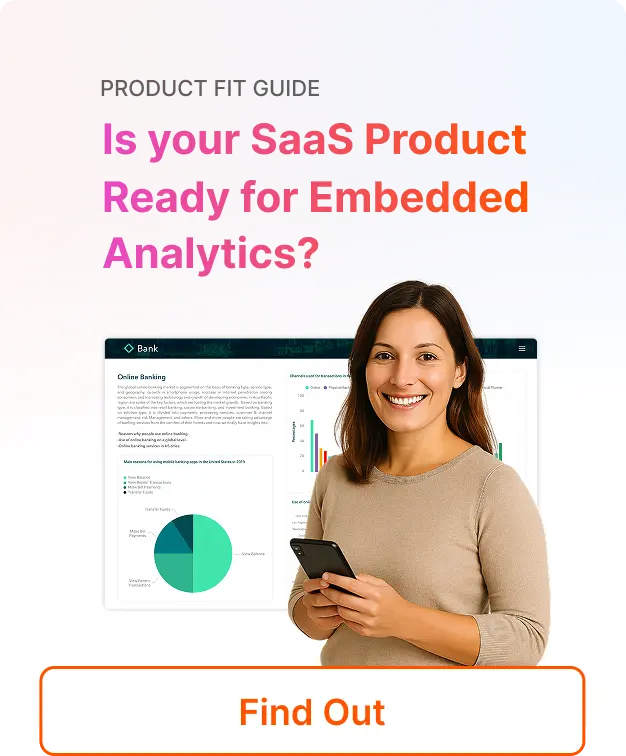
⚡Key Takeaways
- Data monetization is the process of using analytics features in your product to drive revenue
- Data monetization is an option for any SaaS and product teams if you have leverage self-service analytics or an embeddable analytics platform
- Data monetization can be accomplished in just a few steps with your customers once you build your strategy monetize your data
As a product leader, customer-facing analytics are essential to customer success. But are you getting everything out of those insights that you offer?
Are you bringing in 💸revenue 💸 from those analytics?
Data monetization is a strategy that every tech product could leverage but that many still haven’t been able to capitalize on.
There are often good reasons for this miss. For one, building, managing, and maintaining quality customer-facing analytics typically comes with a laundry list of challenges and drawbacks.
Often, though, it boils down to cost. Costs in time. Costs in team bandwidth. And of course, costs in money (not to mention all the headaches!). But what if it didn’t have to be that way?
What if building analytics were easy? And then… What if you could monetize them?
This is your roadmap to monetizing your analytics, from experts who are experienced at helping SaaS companies democratize– and yes, profit off of– their analytics.
Here’s everything you need to know about data monetization in 2026 and beyond.
What is Data Monetization?
Data monetization helps organisations turn insights into value. MIT researchers define it as, “The act of transforming the value created by data initiatives into real money”. In its simplest terms, data monetization is making money from data you own, whether internally or externally.
So, if you run a healthcare software platform, you could monetize the embedded analytics within the software by upcharging your customers for the data. That’s just one example.
Any data that you offer in your analytics platform can be monetized if you approach it with the right strategy.
That may surprise you if you’re not familiar with cloud-based embedded analytics that replace the costs and complexities of building analytics yourself, but we’re here to dispel the myth that offering analytics has to be expensive.
In fact, all of your customer-facing analytics are an opportunity to drive revenue.
Why Data Monetization Matters
Building, maintaining, and managing analytics has a reputation for being a burden.
In traditional models, SaaS and other data-heavy teams had limited options to offer quality customer-facing analytics because such an operation is time consuming, complex, and expensive. Typically it would require a hefty headcount of people to not only build the analytics but also manage all of it.
But with the rise of offerings such as embedded analytics platforms, those constraints are not only eliminated, but in fact reversed so that data becomes a revenue generator instead of a cost driver.
Our team at Qrvey is a data as a service platform, meaning engineering and product teams can build self-service interfaces so users can build their own datasets for custom analytics.
With such self service analytics, teams without technical expertise can provide powerful insights without much heavy lifting.
These insights are moneymakers.
If you are able to easily provide data to your customers in a way that is customizable and totally self-service, you have the upper hand on anyone who has complex data offerings or who requires heavy output from technical experts.
Offering simple and fast self-service analytics allows you to upsell your product’s analytics because that money you bring in would still be a fraction of the cost for your customers to pay compared to other more complex services.
And just like that, you have flipped the script. You don’t just cut costs. You drive revenue.
Preparing for Data Monetization in 4 Simple Steps
When you set out to begin monetizing analytics, there’s a 4-step process that will take your data monetization into the next stratosphere.
First, you trial it with a small subset while implementing your new analytics (hopefully from Qrvey!). Onboard that group and get them acquainted with the new cloud-based setup. Then launch with those select customers. Lastly, expand to your entire customer base.
Here’s that four-step process in detail:
Trial
The trial phase is where you implement the data monetization strategy for a select customer or customers.
The initial trial is where you build enthusiasm around the application for the customer and also an important opportunity for critical learnings so you can successfully offer the analytics and make sure the customers get the most value.
Onboard
As the customer onboards with the new analytics features, it’s important that they offer feedback so you can iterate and optimize the experience. This is the essential moment of evaluation of your application and data requirements, especially for more complex forms of analysis.
Here, your customers can test all the limitations of your platform for things like security and compliance to make sure it’s up to snuff.
From here, personalized onboarding plan and best practices can be defined based on evaluation.
Launch
Your analytics are deployed for your MVP clients or chosen customers. With the analytics launched by your client, you are now able to start generating revenue from them as they use your platform.
It’s recommended that you provide these analytics to a limited number of clients for 1-3 months before wider rollout.
Expand
Now you can deploy your application’s analytics to everyone. Here, you can provide full self-service implementation across user base. At this stage,you are marketing your analytics services to all of your customers.
The process doesn’t end here. In fact, this is an ongoing strategy that will help you monetize your data going forward. It’s important to always learn, iterate and optimize your experience so you can get the most return and your customers receive the most ROI on their investment.
4 Ways to Monetize Data With Embedded Analytics
1. New Products or Add-ons
Your customers are hungry for additional insights, analytics and actions.
Modern embedded analytics platforms make it easy for software companies to build analytics add-ons, or even entire analytics applications, and make them available to their customers for additional revenue.
Analytics are a great way to increase engagement, make your software more sticky and boost your average revenue per user.
2. Upgraded User Licenses
Analytics are a great way to boost the overall value of your software or service, offering a more full-featured experience that can easily translate into higher license fees for all, or a segment of your users.
All-in-on analytics platforms like Qrvey offer data collection, analytics, visualizations, automation, machine learning and a lot more, all in a single platform.
3. Professional Services
Your users are hungry to gain insights from the data you’re collecting.
A modern, cloud-native analytics platform and allow your professional services team to create charts, reports, dashboards and more, while automation can allow for alerts, notifications, insights and actions to be sent automatically as metrics and thresholds are met.
The possibilities are endless and the revenue potential is enormous.
Embedded analytics for SaaS companies have evolved to include a lot more than just charts, reports and dashboards.
4. Data as a Service
SaaS companies can package their unique data collections as subscription-based feeds, offering external businesses strategic intelligence they can’t easily obtain elsewhere.
Transform your aggregated, anonymized data into a standalone product. Create curated data packages that provide valuable market insights, industry benchmarks, or predictive analytics.
This turns your platform’s data exhaust into a direct revenue stream.
Qrvey is an all-in-one analytics solution that includes your entire data pipeline, giving software companies multiple ways to monetize the data they’re already collecting from their customers.
No matter what your goals, from increasing revenues to boosting customer retention. Qrvey can open a world of possibilities.
Best Strategies and Framework for Monetizing Data
There are multiple ways to achieve data monetization. The one that works best for you will depend largely on your specific use case. Here, we’ve mapped out a blueprint to monetize your data.
The Freemium Model
The freemium model creates an accessible entry point for users while establishing clear pathways to revenue.
By offering basic analytics capabilities at no cost, you attract a wide user base and demonstrate tangible value. Advanced features—such as predictive modeling, custom reporting, or enhanced visualization tools—become premium offerings that address specific pain points.
This approach allows users to experience your platform’s fundamental benefits before making financial commitments. The real power of freemium lies in strategically designed upgrade paths that naturally guide users toward paid tiers as their needs evolve. When implemented effectively, this model creates a self-sustaining cycle where free users become advocates, driving both organic growth and conversion to paying customers.
Tiered Pricing Model
A well-structured tiered pricing approach aligns analytics costs with the specific value delivered to different customer segments.
By creating distinct service levels—from essential analysis tools to enterprise-grade capabilities—you establish clear value differentiation that makes purchasing decisions straightforward.
Each tier should represent a meaningful step up in capability, whether through increased data processing capacity, access to specialized analytics modules, or enhanced security features. This model provides natural growth paths as clients’ needs evolve, while giving your sales team defined packages to position.
The key to success lies in crafting tiers that reflect genuine customer segments rather than arbitrary divisions, ensuring each option represents a compelling value proposition for its intended audience.
Add-On or Upsell Model
The add-on approach transforms analytics from a cost center to a revenue-generating asset by positioning specialized modules as valuable enhancements to your core offering.
By unbundling analytics capabilities into targeted components—industry-specific dashboards, advanced forecasting tools, or integration modules—you create multiple purchase opportunities throughout the customer journey.
This model excels at addressing the unique needs of diverse user segments without overwhelming your base product with features relevant to only specific users.
When properly executed, analytics add-ons become strategic differentiators that not only generate direct revenue but also increase product stickiness and customer lifetime value by continuously expanding the ecosystem of solutions available to existing customers.
Customization and Consulting Services
Transforming analytics expertise into service offerings creates high-margin revenue streams while directly addressing complex business challenges.
Custom analytics solutions—tailored to specific industries, workflows, or objectives—command premium pricing by delivering precisely targeted insights unavailable in off-the-shelf solutions.
Implementation and integration services ensure smooth deployment, while training programs accelerate user adoption and value realization.
Ongoing support and optimization services create recurring revenue opportunities while maintaining close customer relationships.
This approach is particularly effective in complex environments where data analysis requirements are highly specialized or where regulatory considerations demand careful oversight. By positioning your team as trusted advisors rather than just technology providers, you create sustainable differentiation in increasingly commoditized markets.
Data monetization use cases and examples
SaaS and product teams can transform their customer analytics into a revenue driving machine in several ways. Here are just a few approaches that you can take:
Self Service Analytics
The beauty of making your product truly self-service is that you can empower your customers with analytics that are easy to use, manage and maintain. Think interactive dashboards they can customize on their own or leverage AI to instantly create data sets. The possibilities are seemingly endless.
By offering flexible, intuitive analytics tools, SaaS companies can transform raw data into a premium feature that will be worth paying high dollar for.
Examples include allowing users to create personalized reports, drill down into metrics, and export insights—all without relying on your support or engineering teams.
Custom Data Collection
You can give all the power to your customers to collect the data they want without bothering you. And that practically sells itself.
Leverage your application’s unique data streams as a monetizable asset. Aggregate anonymized user behavior, performance metrics, or industry-specific insights that provide value beyond individual client experiences.
For instance, a project management tool could offer benchmarking reports comparing productivity across different company sizes or sectors.
Multi-Tenant Applications
Multi-tenant analytics is a must for modern SaaS platforms. With an embedded analytics platform like Qrvey, that allows your analytics to be truly multi-tenant.
And that means data monetization!
You can create tiered data products within your platform where advanced analytics become a revenue-generating add-on. Develop different access levels—basic metrics for standard users, comprehensive dashboards for enterprise clients. Think of a CRM platform offering progressively detailed sales performance insights based on subscription tiers.
Getting Started with Data Monetization Using Qrvey
There’s only one platform that checks all the boxes and can help you monetize your analytics– Qrvey.
We enable your customer-facing analytics to be self-service, multi-tenant, white-labled, fully customizable and easy and simple to use.
And the cherry on top? Qrvey is readymade to help you monetize data with ease. Following the simple steps outlined in this guide, you can be well on your way to data monetization yourself.
Ready to start your data monetization strategy? Book a custom demo to see how you can start driving more revenue today.

As a Senior Content Writer, Megan collaborates with Qrvey’s subject matter experts to develop business and technical content supporting SaaS product managers and developers. Megan has over 25 years’ experience writing about data, analytics, security, and other IT topics. When not behind a computer screen, Megan teaches group fitness classes and gallivants around Maryland’s woods hiking, mountain biking, and foraging.
Popular Posts
Why is Multi-Tenant Analytics So Hard?
BLOG
Creating performant, secure, and scalable multi-tenant analytics requires overcoming steep engineering challenges that stretch the limits of...
How We Define Embedded Analytics
BLOG
Embedded analytics comes in many forms, but at Qrvey we focus exclusively on embedded analytics for SaaS applications. Discover the differences here...
White Labeling Your Analytics for Success
BLOG
When using third party analytics software you want it to blend in seamlessly to your application. Learn more on how and why this is important for user experience.








